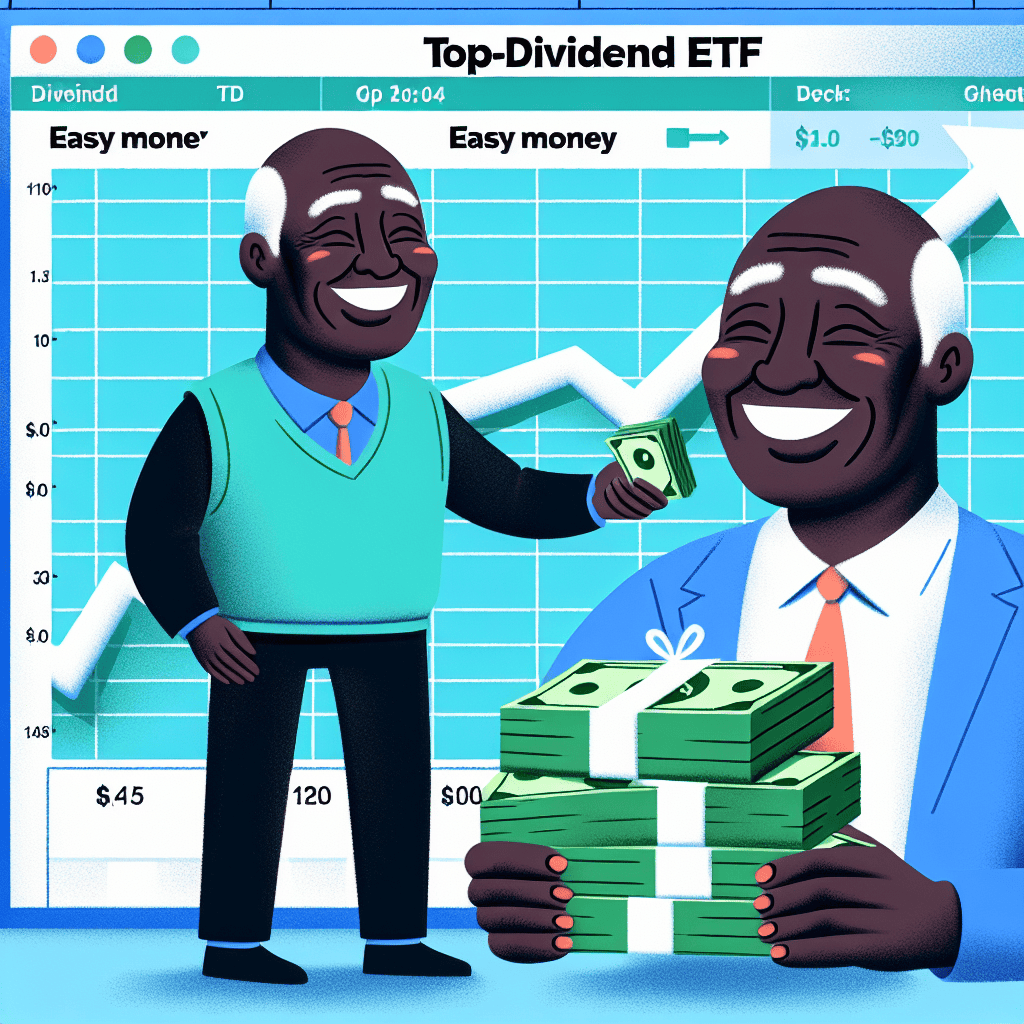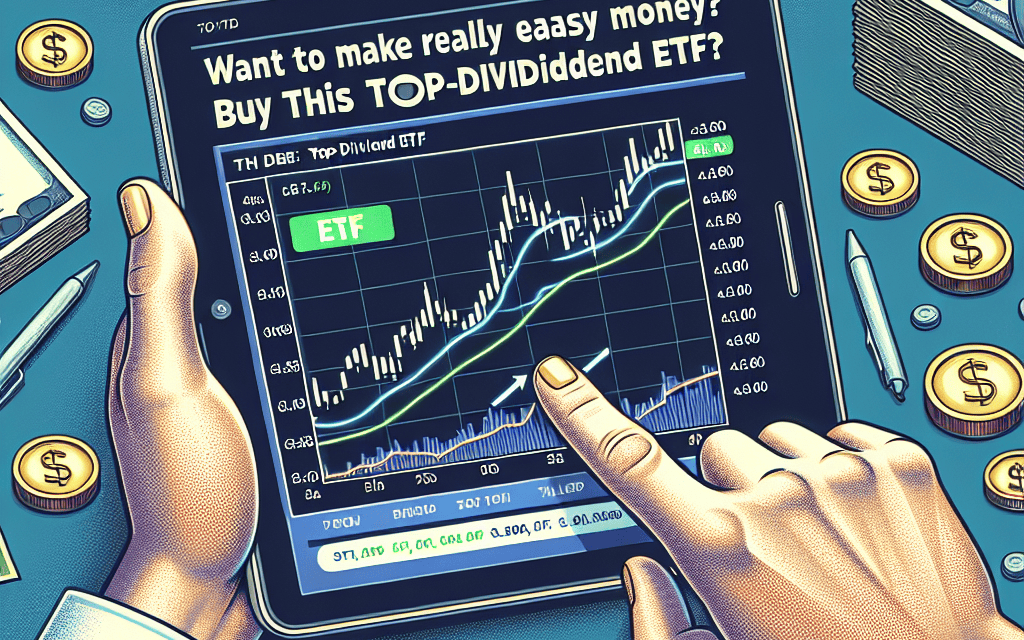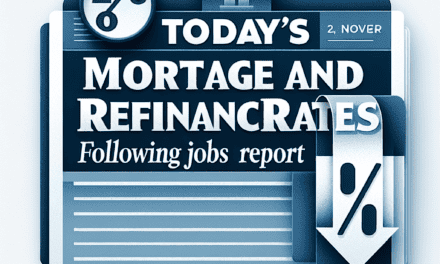“Effortless Earnings: Invest in Top-Dividend ETFs Today!”
Introduction
Investing in dividend-focused exchange-traded funds (ETFs) can be a strategic way to generate passive income and build wealth over time. For those looking to make easy money with minimal effort, a top-dividend ETF offers an attractive opportunity. These funds pool together a diversified portfolio of high-yielding dividend stocks, providing investors with regular income distributions and potential capital appreciation. By investing in a top-dividend ETF, you can benefit from the expertise of professional fund managers who select and manage a basket of dividend-paying companies, ensuring a steady stream of income while mitigating risk through diversification. Whether you’re a seasoned investor or just starting, this approach can be a simple yet effective way to enhance your financial portfolio and achieve your financial goals.
Understanding Dividend ETFs: A Beginner’s Guide
Investing in the stock market can often seem daunting, especially for beginners who are just starting to navigate the complex world of financial instruments. However, one investment vehicle that has gained popularity for its simplicity and potential for steady income is the dividend exchange-traded fund (ETF). Understanding dividend ETFs can be a crucial step for those looking to make easy money with minimal effort. These funds offer a way to invest in a diversified portfolio of dividend-paying stocks, providing investors with regular income and the potential for capital appreciation.
Dividend ETFs are designed to track the performance of a basket of stocks that regularly distribute dividends to their shareholders. These dividends are typically paid out of the company’s profits and are distributed to investors on a regular basis, often quarterly. By investing in a dividend ETF, individuals can gain exposure to a wide range of companies across various sectors, thereby reducing the risk associated with investing in individual stocks. This diversification is one of the key advantages of dividend ETFs, as it helps to mitigate the impact of poor performance by any single company within the fund.
Moreover, dividend ETFs are managed by professional fund managers who have the expertise to select and manage the underlying stocks. This means that investors do not need to spend time researching individual companies or monitoring their performance. Instead, they can rely on the fund manager’s expertise to make informed decisions on their behalf. This hands-off approach is particularly appealing to those who may not have the time or inclination to actively manage their investments.
In addition to providing regular income through dividends, these ETFs also offer the potential for capital growth. As the underlying stocks within the ETF appreciate in value, so too does the value of the ETF itself. This dual benefit of income and growth makes dividend ETFs an attractive option for both income-focused and growth-oriented investors. Furthermore, the reinvestment of dividends can lead to compounding returns over time, enhancing the overall performance of the investment.
Another advantage of dividend ETFs is their cost-effectiveness. Compared to mutual funds, which often have higher management fees, ETFs generally have lower expense ratios. This means that a larger portion of the investor’s money is working for them, rather than being eaten up by fees. Additionally, ETFs are traded on stock exchanges, allowing investors to buy and sell shares throughout the trading day at market prices. This liquidity provides flexibility and ease of access, making it simple for investors to enter or exit their positions as needed.
However, it is important for investors to be aware of the potential risks associated with dividend ETFs. While they offer diversification, they are still subject to market volatility and economic downturns, which can impact the value of the underlying stocks and, consequently, the ETF itself. Therefore, it is crucial for investors to conduct thorough research and consider their risk tolerance before investing in any ETF.
In conclusion, dividend ETFs present a compelling opportunity for investors seeking an easy and efficient way to generate income and achieve long-term growth. By offering diversification, professional management, and cost-effectiveness, these funds can be an excellent addition to a well-rounded investment portfolio. As with any investment, it is essential to understand the associated risks and align the investment with one’s financial goals and risk appetite.
Top-Dividend ETFs: What Makes Them a Smart Investment?
Investing in top-dividend ETFs has become an increasingly popular strategy for those seeking to generate passive income while maintaining a diversified portfolio. These exchange-traded funds, which focus on stocks that pay high dividends, offer a compelling combination of income generation and potential capital appreciation. As investors continue to navigate the complexities of the financial markets, understanding the benefits and mechanics of top-dividend ETFs can provide valuable insights into why they are considered a smart investment choice.
One of the primary advantages of investing in top-dividend ETFs is the steady stream of income they provide. Dividends are typically paid out quarterly, offering investors a regular cash flow that can be particularly appealing in times of market volatility. This consistent income can be reinvested to purchase additional shares, thereby compounding returns over time, or it can be used to supplement other income sources, such as retirement savings. Moreover, the reliability of dividend payments from well-established companies can offer a sense of financial security, especially when interest rates are low and traditional fixed-income investments yield minimal returns.
In addition to income generation, top-dividend ETFs offer diversification benefits that can help mitigate risk. By investing in a basket of dividend-paying stocks across various sectors and industries, these ETFs reduce the impact of poor performance by any single company. This diversification is crucial in managing risk, as it spreads exposure across a wide array of assets, thereby enhancing the stability of the investment. Furthermore, many top-dividend ETFs are managed by experienced professionals who employ rigorous selection criteria to ensure that only financially sound companies with a history of stable or growing dividends are included in the fund.
Another compelling reason to consider top-dividend ETFs is their potential for capital appreciation. While the primary focus of these funds is income generation, the underlying stocks often belong to companies with strong fundamentals and growth prospects. As these companies expand and increase their earnings, the value of their shares can rise, contributing to the overall appreciation of the ETF. This dual benefit of income and growth makes top-dividend ETFs an attractive option for investors seeking a balanced approach to wealth accumulation.
Moreover, the tax advantages associated with dividend income can enhance the appeal of these investments. In many jurisdictions, qualified dividends are taxed at a lower rate than ordinary income, which can result in significant tax savings for investors. This favorable tax treatment, combined with the potential for long-term capital gains, can enhance the after-tax returns of a top-dividend ETF, making it an efficient vehicle for wealth creation.
In conclusion, top-dividend ETFs represent a smart investment choice for those looking to generate easy money through a combination of income and growth. Their ability to provide a steady stream of dividends, coupled with the diversification and potential for capital appreciation, makes them an attractive option for both novice and experienced investors. As financial markets continue to evolve, the stability and reliability offered by top-dividend ETFs can serve as a cornerstone of a well-rounded investment strategy, providing both peace of mind and financial rewards. By understanding the unique benefits of these funds, investors can make informed decisions that align with their financial goals and risk tolerance, ultimately paving the way for a more secure financial future.
How to Choose the Best Dividend ETF for Your Portfolio
When considering the addition of a dividend-focused exchange-traded fund (ETF) to your investment portfolio, it is essential to understand the factors that contribute to selecting the best option. Dividend ETFs are popular among investors seeking a steady income stream, as they pool together a collection of dividend-paying stocks, offering diversification and reducing the risk associated with individual stock investments. To choose the best dividend ETF for your portfolio, several key considerations should be taken into account, ensuring that the investment aligns with your financial goals and risk tolerance.
First and foremost, it is crucial to evaluate the dividend yield of the ETF. The dividend yield represents the annual dividend income as a percentage of the ETF’s current share price. A higher yield can be attractive, as it suggests a greater income potential. However, it is important to balance yield with the stability and sustainability of the dividends. An excessively high yield may indicate underlying issues with the companies in the ETF, such as financial instability or unsustainable payout ratios. Therefore, it is advisable to examine the historical performance of the ETF’s dividends, ensuring that they have been consistent and reliable over time.
In addition to yield, the expense ratio of the ETF is another critical factor to consider. The expense ratio represents the annual fee that investors pay to the fund manager for managing the ETF. A lower expense ratio is generally preferable, as it means that a smaller portion of your investment returns will be consumed by fees. While dividend ETFs tend to have relatively low expense ratios compared to actively managed funds, it is still important to compare the fees among different options to maximize your net returns.
Furthermore, diversification within the ETF is a key element to assess. A well-diversified dividend ETF will include a broad range of sectors and industries, reducing the impact of poor performance in any single area. This diversification helps to mitigate risk and provides a more stable income stream. It is beneficial to review the ETF’s holdings and ensure that it does not overly concentrate on a particular sector, which could expose your portfolio to sector-specific risks.
Another aspect to consider is the ETF’s track record and the reputation of the fund manager. A fund with a long history of stable performance and a reputable manager can provide confidence in the ETF’s ability to deliver consistent returns. Researching the fund manager’s experience and the ETF’s historical performance can offer insights into its potential future performance.
Moreover, it is important to align the ETF with your investment objectives and time horizon. If you are seeking long-term growth, an ETF with a focus on dividend growth may be more suitable. Conversely, if immediate income is your priority, an ETF with a higher current yield might be preferable. Understanding your financial goals will guide you in selecting an ETF that complements your overall investment strategy.
In conclusion, choosing the best dividend ETF for your portfolio involves a careful analysis of several factors, including dividend yield, expense ratio, diversification, track record, and alignment with your investment objectives. By thoroughly evaluating these elements, you can make an informed decision that enhances your portfolio’s income potential while managing risk effectively. As with any investment decision, conducting thorough research and consulting with a financial advisor can further ensure that your choice aligns with your financial goals and risk tolerance.
The Benefits of Investing in High-Dividend ETFs

Investing in high-dividend ETFs can be a strategic move for those looking to generate a steady stream of income while also benefiting from potential capital appreciation. These exchange-traded funds are designed to track indices that focus on high-dividend-yielding stocks, offering investors a diversified portfolio of income-generating assets. One of the primary advantages of investing in high-dividend ETFs is the ability to earn passive income. Unlike individual stocks, which may require constant monitoring and analysis, ETFs provide a more hands-off approach. By pooling together a variety of dividend-paying stocks, these funds distribute dividends to investors, often on a quarterly basis, providing a reliable income stream.
Moreover, high-dividend ETFs offer diversification, which is a key principle in risk management. By investing in a basket of stocks across different sectors and industries, these ETFs reduce the impact of poor performance by any single company. This diversification can help mitigate risks associated with market volatility, making high-dividend ETFs an attractive option for conservative investors. Additionally, the diversification inherent in ETFs can provide exposure to international markets, further enhancing the potential for income and growth.
Another significant benefit of high-dividend ETFs is their cost-effectiveness. Typically, ETFs have lower expense ratios compared to mutual funds, which means investors can keep more of their returns. The low-cost structure of ETFs is particularly appealing to long-term investors who are focused on maximizing their net returns over time. Furthermore, the liquidity of ETFs allows investors to buy and sell shares on the stock exchange throughout the trading day, providing flexibility and ease of access to their investments.
In addition to these benefits, high-dividend ETFs can also serve as a hedge against inflation. As the cost of living rises, the income generated from dividends can help offset inflationary pressures, preserving the purchasing power of an investor’s portfolio. This is particularly important in economic environments where inflation is a concern, as it ensures that the real value of the income received does not diminish over time.
Moreover, high-dividend ETFs can be an excellent tool for retirement planning. For retirees or those nearing retirement, the consistent income from dividends can supplement other sources of retirement income, such as social security or pension plans. This steady income can provide financial stability and peace of mind, allowing retirees to maintain their desired lifestyle without the need to draw down on their principal investments.
Furthermore, the reinvestment of dividends can lead to compounding returns, significantly enhancing the growth potential of an investment portfolio. By reinvesting dividends, investors can purchase additional shares of the ETF, which in turn generates more dividends, creating a cycle of growth that can substantially increase the value of the investment over time.
In conclusion, high-dividend ETFs offer a multitude of benefits that make them an attractive option for investors seeking easy money through passive income. With their ability to provide diversification, cost-effectiveness, inflation protection, and retirement income, these ETFs are a valuable addition to any investment portfolio. By understanding and leveraging the advantages of high-dividend ETFs, investors can achieve their financial goals while enjoying the peace of mind that comes with a well-structured investment strategy.
Comparing Dividend ETFs: Which One Offers the Best Returns?
When considering investment opportunities, particularly in the realm of dividend exchange-traded funds (ETFs), it is crucial to evaluate which options offer the best returns. Dividend ETFs have become increasingly popular among investors seeking a steady income stream, as they provide exposure to a diversified portfolio of dividend-paying stocks. This diversification can mitigate risk while offering the potential for attractive returns. However, not all dividend ETFs are created equal, and understanding the nuances between them can significantly impact an investor’s portfolio performance.
To begin with, dividend ETFs are designed to track indices composed of companies known for paying regular dividends. These funds appeal to investors who prioritize income generation, as they distribute dividends received from the underlying stocks to shareholders. The allure of dividend ETFs lies in their ability to provide a relatively stable income, even during market volatility. However, the key to maximizing returns lies in selecting the right ETF, which requires a thorough comparison of available options.
One of the primary factors to consider when comparing dividend ETFs is the dividend yield. This metric indicates the annual dividend income an investor can expect relative to the ETF’s share price. A higher dividend yield often suggests a more attractive income stream, but it is essential to assess the sustainability of these dividends. Some ETFs may offer high yields due to temporary factors or unsustainable payout ratios, which could lead to future dividend cuts. Therefore, investors should examine the historical performance and dividend growth track record of the ETF’s underlying holdings.
In addition to dividend yield, the expense ratio is another critical consideration. This fee, expressed as a percentage of the fund’s assets, covers the operational costs of managing the ETF. Lower expense ratios are generally more favorable, as they leave more of the fund’s returns in the hands of investors. When comparing dividend ETFs, it is advisable to select those with competitive expense ratios, as high fees can erode the overall returns over time.
Furthermore, the composition of the ETF’s portfolio plays a significant role in determining its performance. Some dividend ETFs focus on specific sectors, such as utilities or consumer staples, which are traditionally known for their stable dividend payments. Others may adopt a broader approach, encompassing a wide range of industries. Investors should align their choice with their risk tolerance and investment goals, considering whether they prefer sector-specific exposure or a more diversified approach.
Another aspect to consider is the ETF’s track record in terms of total return, which includes both capital appreciation and dividend income. While dividend yield is important, total return provides a more comprehensive view of an ETF’s performance. An ETF with a strong history of total returns may indicate effective management and a well-constructed portfolio, making it a more attractive option for investors seeking both income and growth.
In conclusion, selecting the best dividend ETF requires a careful analysis of several factors, including dividend yield, expense ratio, portfolio composition, and total return history. By thoroughly evaluating these elements, investors can identify ETFs that align with their financial objectives and risk tolerance. Ultimately, the right dividend ETF can serve as a valuable addition to an investment portfolio, offering the potential for easy money through a combination of regular income and capital appreciation.
Risk Factors to Consider When Investing in Dividend ETFs
When considering an investment in dividend ETFs, it is crucial to understand the associated risk factors that could impact your returns. While dividend ETFs are often lauded for their ability to provide a steady income stream, they are not without their challenges. One of the primary risks is market volatility. Like all equity investments, dividend ETFs are subject to fluctuations in the stock market. Economic downturns, geopolitical tensions, or unexpected global events can lead to significant price swings, affecting the value of your investment. Therefore, it is essential to assess your risk tolerance and investment horizon before committing to such assets.
In addition to market volatility, interest rate changes pose another significant risk. Dividend-paying stocks often become less attractive when interest rates rise, as investors may shift their focus to fixed-income securities that offer better returns. This shift can lead to a decrease in the price of dividend ETFs, potentially impacting your overall returns. Consequently, staying informed about monetary policy and interest rate trends is vital for investors in dividend-focused funds.
Another factor to consider is the concentration risk associated with dividend ETFs. Many of these funds tend to focus on specific sectors, such as utilities or consumer staples, which are known for their stable dividend payouts. While this can be advantageous during periods of economic stability, it can also lead to increased vulnerability if those sectors face challenges. For instance, regulatory changes or technological disruptions could adversely affect the performance of companies within these sectors, thereby impacting the ETF’s overall performance. Diversification across different sectors and industries can help mitigate this risk, ensuring a more balanced investment portfolio.
Furthermore, currency risk is an important consideration for investors in international dividend ETFs. Fluctuations in exchange rates can affect the value of dividends received from foreign companies, potentially diminishing the returns for investors based in a different currency zone. To manage this risk, some ETFs employ currency hedging strategies, but these can add an additional layer of complexity and cost to the investment. Therefore, understanding the currency exposure of your chosen ETF and its hedging policies is crucial for making informed investment decisions.
Additionally, it is important to be aware of the management fees associated with dividend ETFs. While these funds generally have lower fees compared to actively managed mutual funds, they are not entirely free of costs. Management fees can eat into your returns over time, particularly if the ETF’s performance does not meet expectations. Comparing the expense ratios of different ETFs and considering their historical performance can help you select a fund that aligns with your financial goals.
Lastly, dividend sustainability is a critical factor to evaluate. Not all companies can maintain their dividend payouts during challenging economic times. A company facing declining profits or increased debt may be forced to cut or suspend its dividends, which can negatively impact the ETF’s income stream. Therefore, examining the financial health and dividend history of the companies within the ETF is essential to ensure that the fund can deliver consistent returns.
In conclusion, while dividend ETFs offer an attractive opportunity for generating passive income, they come with their own set of risks that must be carefully considered. By understanding market volatility, interest rate changes, concentration risk, currency fluctuations, management fees, and dividend sustainability, investors can make more informed decisions and better manage the risks associated with these investments.
Maximizing Your Income: Strategies for Investing in Dividend ETFs
Investing in dividend ETFs has become an increasingly popular strategy for those looking to maximize their income with minimal effort. These exchange-traded funds offer a convenient way to gain exposure to a diversified portfolio of dividend-paying stocks, providing investors with a steady stream of income. One of the most compelling reasons to consider dividend ETFs is their ability to generate passive income, which can be particularly appealing in today’s low-interest-rate environment. By investing in a top-dividend ETF, you can potentially enjoy higher yields compared to traditional savings accounts or bonds, making it an attractive option for income-focused investors.
Moreover, dividend ETFs offer the advantage of diversification, which can help mitigate risk. By holding a basket of dividend-paying stocks across various sectors and industries, these funds reduce the impact of any single company’s poor performance on the overall portfolio. This diversification is crucial for investors seeking stability and consistent returns, as it spreads risk across multiple assets. Additionally, dividend ETFs are managed by professional fund managers who have the expertise to select high-quality stocks with strong dividend histories, further enhancing the potential for reliable income.
Another key benefit of investing in dividend ETFs is their liquidity. Unlike individual stocks, which may require significant time and effort to buy and sell, ETFs can be traded on major stock exchanges just like any other stock. This ease of trading allows investors to quickly adjust their portfolios in response to changing market conditions or personal financial needs. Furthermore, the transparency of ETFs, with their holdings and performance data readily available, enables investors to make informed decisions about their investments.
In addition to these advantages, dividend ETFs often come with lower fees compared to actively managed mutual funds. This cost efficiency can have a significant impact on long-term returns, as lower fees mean more of your investment is working for you. Over time, the compounding effect of reinvested dividends and lower expenses can lead to substantial growth in your investment portfolio. Therefore, for those seeking to maximize their income while minimizing costs, dividend ETFs present a compelling option.
However, it is important to consider certain factors when selecting a dividend ETF. Investors should evaluate the fund’s yield, which indicates the income generated relative to its price. While a higher yield may seem attractive, it is essential to assess the sustainability of the dividends being paid. A fund with a history of consistent or growing dividends is generally more reliable than one offering unsustainably high yields. Additionally, examining the ETF’s expense ratio, which reflects the cost of managing the fund, is crucial to ensure that fees do not erode your returns.
Furthermore, investors should consider the ETF’s track record and the reputation of the fund manager. A well-established fund with a history of strong performance and a reputable manager can provide added confidence in the investment. By carefully evaluating these factors, investors can select a top-dividend ETF that aligns with their income goals and risk tolerance.
In conclusion, investing in a top-dividend ETF offers a straightforward and effective strategy for maximizing income. With benefits such as diversification, liquidity, and cost efficiency, these funds provide an attractive option for income-focused investors. By carefully selecting a dividend ETF that meets your investment criteria, you can enjoy the potential for steady income and long-term growth, making it a valuable addition to your investment portfolio.
Q&A
1. **What is the main topic of the article?**
The article discusses an investment opportunity in a top-dividend ETF that offers an easy way to earn money.
2. **What is a dividend ETF?**
A dividend ETF is an exchange-traded fund that focuses on investing in stocks that pay dividends, providing investors with regular income.
3. **Why is the ETF considered a good investment?**
The ETF is considered a good investment because it offers a reliable source of income through dividends and has a strong track record of performance.
4. **What are the benefits of investing in a dividend ETF?**
Benefits include regular income from dividends, diversification, and potential for capital appreciation.
5. **What should investors consider before buying this ETF?**
Investors should consider the ETF’s expense ratio, dividend yield, historical performance, and how it fits into their overall investment strategy.
6. **How does the ETF generate income for investors?**
The ETF generates income by investing in a portfolio of dividend-paying stocks, which distribute earnings to shareholders in the form of dividends.
7. **What is the potential risk associated with this ETF?**
Potential risks include market volatility, changes in dividend policies of underlying stocks, and interest rate fluctuations that can affect dividend yields.
Conclusion
Investing in a top-dividend ETF can be an effective strategy for generating passive income with relatively low effort. These ETFs typically consist of a diversified portfolio of high-yield dividend stocks, providing investors with regular income distributions and potential capital appreciation. By choosing a well-managed dividend ETF, investors can benefit from professional management, diversification, and the potential for steady returns, making it an attractive option for those seeking easy and reliable income streams. However, it’s important to consider the associated risks, such as market volatility and interest rate fluctuations, and to ensure that the investment aligns with one’s financial goals and risk tolerance.





